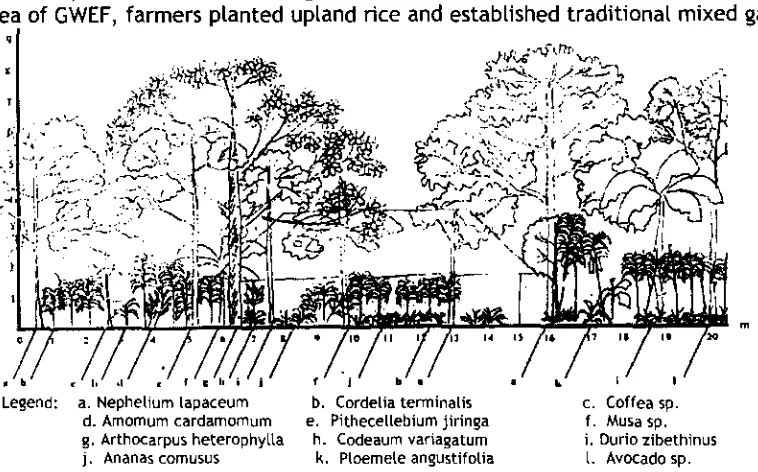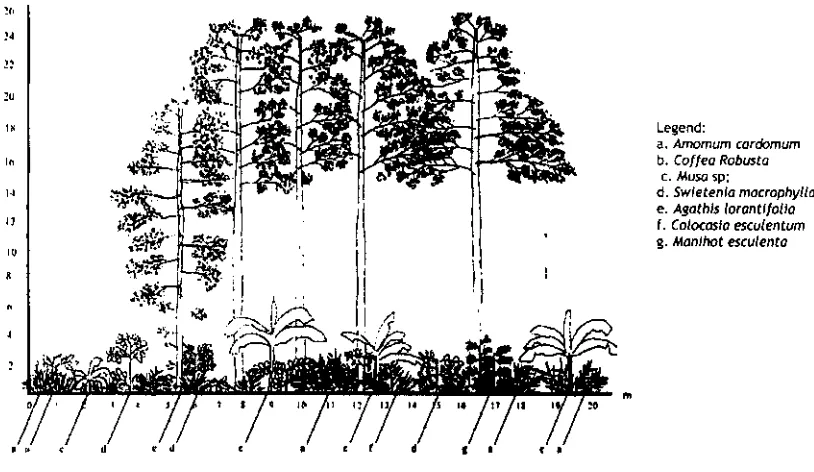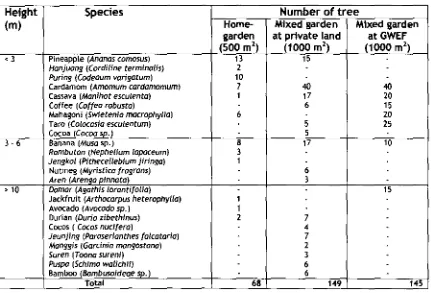ANALYSIS OF LABOR
ALLOCATION AND
INCOME CONTRlBUTlON OF
AGROFORESTRY SYSTEMS TO
THE FARMER
HOUSEHOLDS
AT GUNUNG
WALAT EDUCA'TIONAL
FORESTLeti
Sundawatiand M.
lskandar Zutkurnaln
Laboratory
of
Forestry Sodo-Economics and Policy The Department of Forest Management Facultyof
Forestry,
Bogor Agiicul tural
Universityb
PO
Box 168, Bogor 16001, IndonesiaEmail:
akecuiw@cbn.
net. ldIntroduction
Before 1997's
economic crisis i n Indonesia, tocal people surrounding the Gunung
WalatEducation Forest
{GWEF)lived mainly from farming activities
on
their own land
andnon- farm activities outside their vitlages,
such asmining Labor, construction labor,
etc. Private land was maria@
by local farmers
inform
of
rice fieldand gardens.
Economic crisis
-
andthen political crisis i n Indonesia-
have
causedthe leaping of
prices
which then drive
thelocal people surrounding the
GWEFto encroach the
forest areato fulfill their
needespecially
forstaple food. So that the local
farmerscleared
forest area and
planted rice, cassava, corn,etc. Now various farming
systems haveto
be
managed
by thefarmen
to fulfill their househotd
needs. It meansthat the farmer
household must
allocate
theirtime
andlabor force more than before the economic
crisis.
Introduction
ofagroforestry project
byFaculty of
Forestry,IPB-
asmanager
ofthe
GWEF, and
being funded
byKorea
forrestoration of forest condition involved the local
encroaching farmers, needed bigger portion of
locaIfarmers' working time and
number
oflabor
for theproject. Experience i n
the pastshowed
thatfarmers allocated
their working time
andlabor for
aproject only
assecond
priorityafter
theirown land
and other main activities.
Toavoid
anoverburden to the farmers which could
causethe
failure of theproject and to increase
theinterest
of farmersinto the project,
theexisted farming
systemespecial{y agroforestry
systems andl a b atlocation of farmer
household inciuding
theincome contribution from various agroforestry system should
be studied.
Objectives
I. To
identify
thetypes
ofexisting agroforestry
system inthe
GWEF andsurrounding
villages
2.
Tocalculate
farmers'labor atlocation and time allocation
forexisting agroforestry
systems maintenance
3. To
analyze the income contribution of existing agroforestry systems into
thetotal
household income
4.
To analyze
thecorrelation between agroforestry farming
areawith number
of
labor and working time allocation.
Methodology
farmer households i n GWEF. Primary data were collected through interview using structured and unstructured questionnaires and secondary data were collected from various relevant institutions. The study was conducted on February until May, 2002.
Results and Discussion
Existing Agroforestry Systems
in
the Study SiteMost of encroaching farmers i n GWEF practiced traditional agroforestry system in their own field, i n the form of home gardens and traditional mixed gardens. A t the forest area of GWEF, farmers planted upland rice and established traditional mixed gardens.
Legend: a. Nephelium lapaceurn b. Cordelia terminalis c. Coffea sp.
d. Amomum cardamomurn e. Pithecellebium jiringa f . Musasp. g. Arthocarpus heterophylla h. Codeaum variagaturn i. Durio zibethinus
[image:2.528.62.441.147.383.2]j
.
Ananas cornusus k. Plwrnele angustifolia I. Avocado sp.Figure 1. Profile of Typical Home garden i n the Villages Surround
GWEF
Common species planted i n the home gardens were fruit trees such as rambutan (NepheIium
iapaceum),
jack fruit(Artocarpus
indicus), durian(Durio
zibe
thinus); ornamental plants such as hanjuang (CordiIineterminalis),
suji(PloemeIe
angustifoiia),
puring(Codeanurn
v a r i g a t u m ) and food crops such as cassava (Manihot esculenta) and taro(Colocasio
esculentum). Profileof
typical home garden i n the study site i s showed i n Figure 1. Beside fruit trees and agriculture crops the farmers commonly planted wood species such as sengon (Paraserionthesfolcataria),
surena. Manihot esculenta b. Colocasia esculentum c. Cocos nucifera d. Paraserianthes falcataria
[image:3.528.33.427.27.280.2] [image:3.528.33.440.380.616.2]e. Amomum cardamomurn f. Myristica fragrans g. Ananas commus h. Garcinia mangostana i. Arenga pinata j. Toona sureni k. Cocoa sp. I.. Schima watichii m. Durio zibethinus n. Coffea sp. o. Barn busodeae sp.
Figure 2. Profile of typical mixed garden in private land of study site
In the forest area of GWEF cassava, taro, coffee, banana and cardamom
(Amomurn
curdomum) were planted under already existed stands of damar (Agothisloratifolio)
and mahogany (Swietenia
macrophylla).
Profile of typical mixed garden in the GWEF located on the study site i s shown in Figure 3.111
!P
I.
-.
!U
18 Legend:
a. Amomurn mrdwnum
In b. Coffeo Robusta
c. MUM sp:
1.1 d. Swletenla mocraphyIio
e. Agothb lorontlfoila
11 f . C o l ~ m f o escuientum
g. Monlhot esculento
I V It
4
?
m
/
/
7/
171
IJ
14/"/!/I#
r r c 1 r l c 8 c d l l c a
Figure 3. Profile of typical mixed garden in the area of GWEF
private land, except for Agathis and Swietenia which are originat tree species of the GWEF (see Table 1). It means also that the farmers pianted only well known plant species in the GWEF which. Most of
piant
species planted in the GWEF was annual crops. Coffee was considered as cash crop which could be harvested i n shorter time than woody trees. Uncertainty of farmers' land use right in the GWEF was the reason why farmers planted annual crops rather than highly valuable woody trees.Number of plant species i n the mixed garden on private lands as well i t s standing stocks were the highest. Valuabie woody tree species also existed, such as Paraserianthes
falcatoria,
Schimo walichii and Toona sureni. That means farmers knew well and willing to plant woody tree species which i s important for the aim of forest restoration project.Table 1. Species and Standing Stock of Home garden, Mixed Garden at private land and a t the GWEF according to Height Stratum
Table 2 showed that average area of home garden owned by a farmer was about 0.04 ha. To manage the home garden the farmer
needed
23 man days per yearor
572.7 man days/ha/years. Average area of mixed garden owned by farmer was about 0.25 ha which needed 30.5 man days per year or 121.8 man days/ha/year. In the GWEF, encroaching farmers occupied about 0.3 ha which needed 74 man days per year or about 246.8 man days/ha/year.Height
(m)
< 3
3 - 6
'
Species
Pineapple (Anoms comosus)
Hanjwng (Cordiline terminalis)
Puring (Codeoum varigotum)
Cardamom (Amomum cardamomurn) Cassava (Manihot esculentu) Coffee (Coffeo robusto)
Mahagoni (Swietenia mrophyIla)
Taro (Colocasia esculentum)
Cocoa (Cocoa s p . )
Banana (Mum sp.)
Rambuton (Nephelfum lapaceurn) Jengkol (Pithecellebium jiringo)
Nutmeg (Myristica frograns) Aren (Arengo pinnuta) Darnar (Agathis loranti~ollo) Jackfruit (Arthmorpus hel~rophyila) Avocado (Avocado s p . )
Durian (Durio zibethlnus) Cacos ( Cocos nucifera)
Jeunjlng (Paraserianthes falcotarfa) Manqgis (Garcinio mongostam)
Suren (Toono surenj)
Puspa (Schirno w l i c h i i ) Bambm (Bornbusojdeae sp.)
Total
tree
Mixed garden
at GWEF (1000 m2)
40 20 15 20 25 10 15 145 Home- garden
(500 m2) 13 2 10 7 1 6 8 3 1 1 1 2 68 Number of Mlxed prden at prfvate land
[image:4.554.72.503.231.524.2]Table 2. Average land ownership and labor allocation according to type of agroforestry system
Type of AF System Land Ownership Labor Allocation (man
(ha) days1 years)
Home garden 0.04 23.0
Mixed garden in private land 0.25 30.5
Mixed garden in GWEF 0.30 74.0
Total 0.59 127.5
Activities conducted by farmers to manage their farming were land preparation, planting, weeding, fertilizing, harvesting and post harvesting. Because average number of family labor was only 3 people (father, mother and 1 child), thus to manage their farming, labor needed to be hired, especially during land preparation activity.
Income
ContributionAverage land ownership of the farmers was very low (see
Tabie
1 ), therefore besides farming they seek other occupation to fulfill their household needs. Other income sources were from paddy field, labor at agriculture field, construction (abor, petty trading and home industry. From the home garden the farmers could get income about Rp 376,590Iyear or about US$
41.84, from traditional mixed garden Rp 878,70O/year or US $ 97.631year and from the forest area they could get income only about Rp 469,19O/year or about US $ 52.731year. Total income from the agroforestry system was Rp 1,724,480/year or US$
191.6/year.lncome contributions of home garden, traditional mixed garden at private land and mixed garden at forest area were 6 96, 14 % and
7.5
% respectively. Total income contribution of agroforestry system to household income was about 27.5 %. The low income contribution of agroforestry system practiced traditionally by farmers showed that their agroforestry systems should be improved to get highly economical benefit and ecologically, so that the welfare of the farmers could be increased.Table 2. lncome Contribution of Agroforestry Systems
Source of Income Average Income Income Contribution
( ~ p l year)
1. Agroforest ry System:
(%I
a. Home garden 3 76,590 6.0
b. Mixed garden i n private land 878,700 14.0
c. Mixed garden i n GWEF 469,190 7.5
2. Paddy field 1,917,430 30.6
2. Non-agriculture sector 2,624,510 41 -9
Total 6,266,420 100.0
Conclusionss and Recommendation
Concl usionss
a. Farmers surrounding the GWEF practiced home
garden
and traditional mixed garden in private land and in the forest area of GWEF. [image:5.516.35.458.49.130.2]c. The existence of valuable tree species in their private mixed gardens showed that farmers knew well forest tree species and willing to plant woody trees.
d. Farmer household tend to allocate their iabor to manage their mixed garden i n the GWEF implied high needs of income and food from outside resources.
e. Even though contribution of agroforestry systems into household income was s t i l l low, that contribution was very meaningful for farmer household.
Recommendat
ions
a. Traditionai agroforestry practiced by local farmers i n the private land as well as i n the forest area of GWEF should be improved to increase i t s contribution to the farmer household income
b. lntroduction of improved agroforestry system i s necessary to improve farmer know ledge
c. Introduction of agroforestry
product
processing could strengthen farmer income seneration.References
Kasryno, F. 1984. Prospek Pembangunan Ekonomi Pedesaan Indonesia. Yayasan Obor l ndonesia Jakarta.
Muljadi. 1987. Distribusi Tenaga Kerja dalam Pola Usahatani TanamadTernak di Batu Marta, Sumatera Selatan. Departemen Pertanian. Jakarta.
Nair, P. K. R. 1993. Introduction to Agroforestry. Kiuwer Academic Publisher. Dodrecht. The Netherland.
Nurmanaf, A. R.,
M.
Gunawan dan S. Hartoyo. 1978. Penyediaan dan Kebutuhan Tenagadi
Sektor Pertanian. Penelitian Tahap Ill. Survey Agro Ekonomi. BiroPerencanaan Departemen Pertanian. Jakarta.
c. The existence of valuable tree species i n their private mixed gardens showed that farmers knew well forest tree species and willing to plant woody trees.
d.
Farmer household tend to allocate their labor to manage their mixed garden i n the GWEF implied high needs of income and food from outside resources.e. Even though contribution of agroforestry systems into household income was s t i l l low, that contribution was very meaningful for farmer household.
Recornmendo
tions
a. Traditional agroforestry practiced by
local
farmers i n the private land as well as i n the forest area of GWEF should be improved to increase i t s contribution to the farmer household incomeb. Introduction of improved agroforestry system i s necessary to improve farmer knowledge
c. lntroduction of agroforestry product processing could strengthen farmer income generation.
References
Kasryno, F. 1 984. Prospe k Pem bamjunan Ekonomi Pedesaan Indonesia. Yayasan Obor l ndonesia Jakarta.
Muljadi.
1987. Distri busi Tenaga Kerja dalam Poia Usahatani Tanaman ITernak di Batu Marta, Sumatera Selatan. Departemen Pertanian. Jakarta.Nair, P.K.R. 1993. lntroduction to Agroforestry. Kluwer Academic Publisher. Dodrecht. The Netherland.
Nurmanaf, A. R., M. Gunawan dan
5.
Hartoyo. 1978. Penyediaan dan Kebutuhan Tenaga di Sektor Pertanian. Penelitian Tahap Ill. Survey Agro Ekonomi. Biro Perencanaan Departemen Pertanian. Jakarta.


